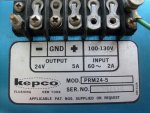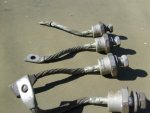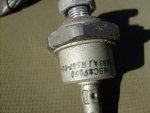aboonski
Member
- 721
- 8
- 18
- Location
- West Melbourne Florida
I just came across a power supply that I have had in storage for years and decided to wire it up to see if it works. I got this back when I was assigned to the USAF Hospital Homestead, Homestead AFB Florida back in the early 80's At the time they were renovating the biomedical laboratory and new equipment came in to replace the old; this power supply ran one of piece of equipment (no idea which one) but it would up in the dumpster. I used an old power cord from a washing machine that I scrapped out which had the ground wire in the center, added some solderless connectors and hooked the thing up - it works great! Voltage output is a steady 24.2 volts. I plan to use it to test out 24 volt items (like headlight bulbs, lift pumps, tail light assemblies, etc.). I thought about using it for a 24 volt battery charger but it would not work unless it were slightly higher in voltage. It does put out 5 amps though which should provide enough power to test almost any 24 volt item - with the exception of a starter of course! I'll provide a photo of the data sticker.
Attachments
-
77.9 KB Views: 16




